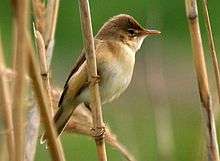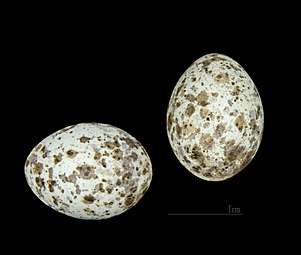Eurasian reed warbler
The Eurasian reed warbler, or just reed warbler (Acrocephalus scirpaceus) is an Old World warbler in the genus Acrocephalus. It breeds across Europe into the temperate western Palaearctic. It is migratory, wintering in sub-Saharan Africa.
| Eurasian reed warbler | |
|---|---|
 | |
| Song recorded in Surrey, England | |
| Scientific classification | |
| Kingdom: | Animalia |
| Phylum: | Chordata |
| Class: | Aves |
| Order: | Passeriformes |
| Family: | Acrocephalidae |
| Genus: | Acrocephalus |
| Species: | A. scirpaceus |
| Binomial name | |
| Acrocephalus scirpaceus (Hermann, 1804) | |
 | |
| Distribution of the eurasian reed warbler:
Nesting Wintering Throughout the entire year | |
Etymology
The genus name Acrocephalus is from Ancient Greek akros, "highest", and kephale, "head". It is possible that Naumann and Naumann thought akros meant "sharp-pointed". The specific scirpaceus is from Latin and means "reed".[2]
An older scientific name for the reed warbler was Acrocephalus streperus (Vieill.).[3]
Habitat and population density
This small passerine bird is a species found almost exclusively in reed beds, usually with some bushes. Direct counts of territorial males in suitable habitat and sampling the population sex-ratio can be a proper alternative to inference-rich predictive modeling based on imperfect habitat-extrapolation of densities of reed warblers at large spatial scales.[4]
| Population densities of Eurasian reed warblers (mean±SD) in Europe | ||||||||||||||||
|---|---|---|---|---|---|---|---|---|---|---|---|---|---|---|---|---|
| Country | Method | Pairs/ha | Birds/ha | Nests/ha | Ref. | |||||||||||
| UK | Nest | - | - | 17.9±10.4 | [5] | |||||||||||
| Spain | Census point | - | 3.9 | - | [6] | |||||||||||
| Spain | Transect | - | 7.8 | - | [4] | |||||||||||
| Slovakia | Nest | - | - | 29.1±31.1 | [7] | |||||||||||
| Spain | Nest | 12.6±11.3 | - | - | [8] | |||||||||||
| Romania | Nest | 21.0±26.9 | - | - | [8] | |||||||||||
| Romania | Nest | - | - | 21.0±26.9 | [8] | |||||||||||
| France | Nest | - | - | 40.0 | [8] | |||||||||||
| Romania | Nest | - | - | 21.0±26.9 | [8] | |||||||||||
| France | Nest | - | - | 40.0 | [8] | |||||||||||
| Czech Republic | Nest | - | - | 63. | [8] | |||||||||||
| Germany | Nest | - | - | 44.0±15.6 | [8] | |||||||||||
| Poland | Nest | - | - | 57.0 | [8] | |||||||||||
| Lithuania | Nest | - | - | 5.0 | [8] | |||||||||||
| Denmark | Nest | - | - | 25.0 | [8] | |||||||||||
| Norway | Nest | - | - | 8.0 | [8] | |||||||||||
Description
This is a medium-sized warbler, 12.5–14 cm in length. The adult has an unstreaked brown back and buff underparts. The forehead is flattened, and the bill is strong and pointed. The sexes are identical, as with most warblers, but young birds are richer buff below. The Eurasian reed warbler looks similar to the great reed warbler, but the great reed warbler is larger in size and has a stronger supercilium.
Song
The song is a slow, chattering jit-jit-jit with typically acrocephaline whistles and mimicry added.
Food
Like most warblers, it is insectivorous, but will take other small food items, including berries.
Nesting
The 3–5 eggs are laid in a basket nest in reeds. The chicks fledge after 10 or 11 days. This species is usually monogamous.[9] The Eurasian reed warbler is one of the species that are brood parasitised by the common cuckoo.
_(14746972441).jpg) Placement of nest
Placement of nest.jpg) View on nest with clutch
View on nest with clutch Common cuckoo chick fed by reed warbler adult
Common cuckoo chick fed by reed warbler adult Reed warbler eggs
Reed warbler eggs
References
- BirdLife International (2019). "Acrocephalus scirpaceus (amended version of 2017 assessment)". IUCN Red List of Threatened Species. 2019: e.T22714722A155436305. Retrieved 25 January 2020.CS1 maint: ref=harv (link)
- Jobling, James A (2010). The Helm Dictionary of Scientific Bird Names. London: Christopher Helm. pp. 30, 350. ISBN 978-1-4081-2501-4.
- For instance in Naumann, Johann Friedrich (1897). Naturgeschichte der Vögel Mitteleuropas. 2. OCLC 603365339 (all editions).; see also:

- Frías, O.; Bautista, L. M.; Dénes, F. V.; Cuevas, J. A.; Martínez, F.; Blanco, G. (2018). "Influence of habitat suitability and sex-related detectability on density and population size estimates of habitat-specialist warblers". PLoS ONE. 13 (7): 020148. Bibcode:2018PLoSO..1301482F. doi:10.1371/journal.pone.0201482. PMC 6066240. PMID 30059562.
- Bibby, C. J.; Thomas, D. K. (1985). "Breeding and diets of the reed warbler at a rich and a poor site". Bird Study. 32: 19–31. doi:10.1080/00063658509476851.
- Parcuellos, M. (1997). "Comparative analysis between the passerine communities of great reed beds (Arundo donax) and reed beds (Phragmites australis) in southeastern Iberia". Ardeola. 44: 105–108.
- Prokešová, J.; Kocian, L. (2004). "Habitat selection of two Acrocephalus warblers breeding in reed beds near Malacky (Western Slovakia)" (PDF). Biologia Bratislava. 59: 637–644.
- Stokke, B. G.; Hafstad, I.; Rudolfsen, G.; Bargain, B.; Beier, J.; Campas, D. B.; Dyrcz, A.; Honza, M.; Leisler, B.; Pap, P. L.; Patapavicius, R.; Prochazka, P.; Schulze-Hagen, K.; Thomas, R.; Moksness, A.; Møller, A. P.; Roskaft, E.; Soler, M. (2007). "Host density predicts presence of cuckoo parasitism in reed warblers". Oikos. 116 (6): 913–922. doi:10.1111/j.2007.0030-1299.15832.x.
- Leisler, B. & Wink, Michael (2000): Frequencies of multiple paternity in three Acrocephalus species (Aves: Sylviidae) with different mating systems (A. palustris, A. arundinaceus, A. paludicola). Ethology, Ecology & Evolution 12: 237–249. PDF fulltext
External links
- Eurasian reed warbler videos, photos & sounds on the Internet Bird Collection
- Avibase
- Ageing and sexing (PDF; 2.3 MB) by Javier Blasco-Zumeta & Gerd-Michael Heinze
Bibliography
- Kishkinev, D., Chernetsov, N., Pakhomov, A., Heyers, D., and Mouritsen, H. (2015). Eurasian reed warblers compensate for virtual magnetic displacement. Curr. Biol. 25, R822–R824
